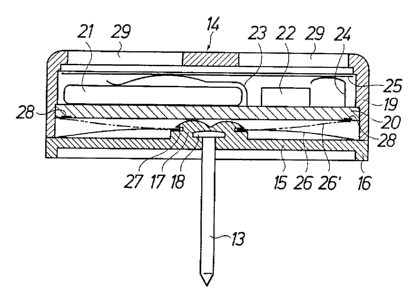Some of the information on this Web page has been provided by external sources. The Government of Canada is not responsible for the accuracy, reliability or currency of the information supplied by external sources. Users wishing to rely upon this information should consult directly with the source of the information. Content provided by external sources is not subject to official languages, privacy and accessibility requirements.
Any discrepancies in the text and image of the Claims and Abstract are due to differing posting times. Text of the Claims and Abstract are posted:
| (12) Patent: | (11) CA 2187947 |
|---|---|
| (54) English Title: | ALARM TAG |
| (54) French Title: | ETIQUETTE D'ALARME ANTIVOL |
| Status: | Deemed expired |
| (51) International Patent Classification (IPC): |
|
|---|---|
| (72) Inventors : |
|
| (73) Owners : |
|
| (71) Applicants : |
|
| (74) Agent: | BORDEN LADNER GERVAIS LLP |
| (74) Associate agent: | |
| (45) Issued: | 2003-07-01 |
| (86) PCT Filing Date: | 1995-04-11 |
| (87) Open to Public Inspection: | 1995-10-19 |
| Examination requested: | 2001-12-19 |
| Availability of licence: | N/A |
| (25) Language of filing: | English |
| Patent Cooperation Treaty (PCT): | Yes |
|---|---|
| (86) PCT Filing Number: | PCT/SE1995/000385 |
| (87) International Publication Number: | WO1995/027959 |
| (85) National Entry: | 1996-10-15 |
| (30) Application Priority Data: | ||||||
|---|---|---|---|---|---|---|
|
Alarm tag comprising two parts one
of which (12) is provided with a pin (13)
attached to said one part (12) to be located
on one side of a product (11) with the pin
extending through the product into locking
engagement with the other part (10) located
on the opposite side of the product. One
of these parts has means for activating
an alarm device in said other part and or
an external alarm device by the alarm tag
being carried into or out of an external
field. Furthermore, one part comprises a
contact element (26) operatively related to
said alarm device or a second alarm device,
said contact element normally being in a
first position in which the alarm device is
silent but being constructed to be switched
via the pin attachment to a second position
(26') in order to activate the alarm device
at attempt to separate the two parts of the
alarm tag.
Une étiquette d'alarme antivol se compose de deux parties dont l'une (12) est munie d'une épingle (13) fixée sur ladite partie (12) destinée à être placée sur une face d'un produit (11), l'épingle traversant le produit et s'enclenchant sur l'autre partie (10) se présentant contre la face opposée du produit. L'une des parties comporte un circuit déclenchant, soit un dispositif d'alarme situé dans l'autre partie, soit un dispositif d'alarme externe lors de l'entrée ou de la sortie de l'étiquette d'alarme antivol par rapport à un champ externe. En outre, l'une des parties comporte un élément contact (26) actionnant le dispositif d'alarme. Une première position repos de l'élément contact correspond au silence du dispositif d'alarme. Mais par construction, cette première position peut être transformée au moyen de la fixation à épingle en une seconde position repos (26') permettant d'actionner le dispositif d'alarme en cas de tentative de désolidarisation des deux parties de l'étiquette d'alarme antivol.
Note: Claims are shown in the official language in which they were submitted.
Note: Descriptions are shown in the official language in which they were submitted.

For a clearer understanding of the status of the application/patent presented on this page, the site Disclaimer , as well as the definitions for Patent , Administrative Status , Maintenance Fee and Payment History should be consulted.
| Title | Date |
|---|---|
| Forecasted Issue Date | 2003-07-01 |
| (86) PCT Filing Date | 1995-04-11 |
| (87) PCT Publication Date | 1995-10-19 |
| (85) National Entry | 1996-10-15 |
| Examination Requested | 2001-12-19 |
| (45) Issued | 2003-07-01 |
| Deemed Expired | 2005-04-11 |
There is no abandonment history.
| Fee Type | Anniversary Year | Due Date | Amount Paid | Paid Date |
|---|---|---|---|---|
| Application Fee | $0.00 | 1996-10-15 | ||
| Maintenance Fee - Application - New Act | 2 | 1997-04-11 | $100.00 | 1997-04-03 |
| Registration of a document - section 124 | $0.00 | 1997-04-24 | ||
| Maintenance Fee - Application - New Act | 3 | 1998-04-14 | $100.00 | 1998-03-23 |
| Maintenance Fee - Application - New Act | 4 | 1999-04-12 | $100.00 | 1999-03-22 |
| Maintenance Fee - Application - New Act | 5 | 2000-04-11 | $150.00 | 2000-03-13 |
| Registration of a document - section 124 | $50.00 | 2000-09-11 | ||
| Maintenance Fee - Application - New Act | 6 | 2001-04-11 | $150.00 | 2001-03-13 |
| Request for Examination | $400.00 | 2001-12-19 | ||
| Maintenance Fee - Application - New Act | 7 | 2002-04-11 | $150.00 | 2002-03-12 |
| Maintenance Fee - Application - New Act | 8 | 2003-04-11 | $150.00 | 2003-03-21 |
| Final Fee | $300.00 | 2003-04-10 |
Note: Records showing the ownership history in alphabetical order.
| Current Owners on Record |
|---|
| MW TRADING (UK) LTD. |
| Past Owners on Record |
|---|
| HOLMGREN, BERTIL |
| MW INTERNATIONAL LTD. |